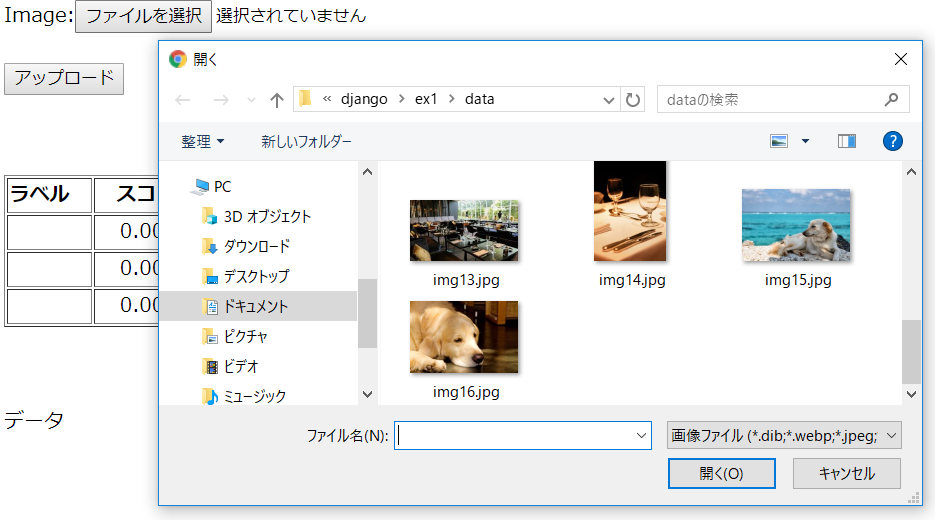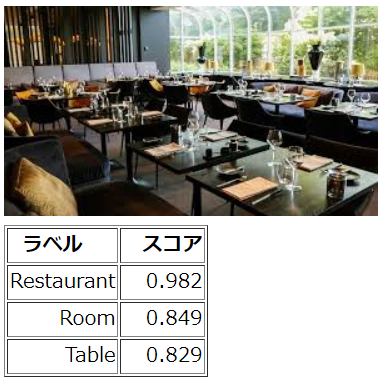目的
- Django と Google Vision API の使い方に慣れる。
- GAE でデプロイすることに慣れる。
- csvファイルをダウンロードする方法を学ぶ。
コード
動作確認
ファイルを選択しアップロード。
ラベリング結果。
models.py
from django.db import models
class Photo(models.Model):
image = models.ImageField(upload_to='app1/')
forms.py
from django import forms
from .models import Photo
class PhotoForm(forms.ModelForm):
class Meta:
model = Photo
fields = ('image',)
class ImageForm(forms.Form):
image = forms.ImageField()
views.py
from django.http.response import HttpResponse
from django.shortcuts import render, redirect
from .forms import PhotoForm, ImageForm
from .models import Photo
import requests
import base64
import json
def upload(request):
ENDPOINT_URL = 'https://vision.googleapis.com/v1/images:annotate'
api_key = 'your_api_key'
if request.method == 'POST':
form = PhotoForm(request.POST, request.FILES)
if form.is_valid():
form.save()
return redirect('app1:upload')
else:
form =PhotoForm()
objects = Photo.objects.all()
last = objects.last()
if len(objects) > 0:
with open(last.image.url[1:], 'rb') as f:
content = base64.b64encode(f.read()).decode('UTF-8')
image_requests = {
'image': {'content': content},
'features': [{
'type': 'LABEL_DETECTION',
'maxResults': 3
}]
}
response = requests.post(ENDPOINT_URL,
data=json.dumps({"requests": image_requests}),
params={'key': api_key},
headers={'Content-Type': 'application/json'})
description1 = response.json()['responses'][0]['labelAnnotations'][0]['description']
score1 = response.json()['responses'][0]['labelAnnotations'][0]['score']
description2 = response.json()['responses'][0]['labelAnnotations'][1]['description']
score2 = response.json()['responses'][0]['labelAnnotations'][1]['score']
description3 = response.json()['responses'][0]['labelAnnotations'][2]['description']
score3 = response.json()['responses'][0]['labelAnnotations'][2]['score']
else:
description1 = ''
score1 = 0
description2 = ''
score2 = 0
description3 = ''
score3 = 0
d = {
'form': form,
'objects': objects,
'last': last,
'description1': description1,
'score1': '{:.3f}'.format(score1),
'description2': description2,
'score2': '{:.3f}'.format(score2),
'description3': description3,
'score3': '{:.3f}'.format(score3),
}
return render(request, 'app1/upload.html', d)
def upload2(request):
from PIL import Image
from io import BytesIO
ENDPOINT_URL = 'https://vision.googleapis.com/v1/images:annotate'
api_key = 'your_api_key'
if request.method == 'POST':
form = ImageForm(request.POST, request.FILES)
if form.is_valid():
image = request.FILES['image']
#image = form.cleaned_data['image']
img = Image.open(image)
buffered = BytesIO()
img.save(buffered, format="JPEG")
content = base64.b64encode(buffered.getvalue()).decode('UTF-8')
image_requests = {
'image': {'content': content},
'features': [{
'type': 'LABEL_DETECTION',
'maxResults': 3
}]
}
response = requests.post(ENDPOINT_URL,
data=json.dumps({"requests": image_requests}),
params={'key': api_key},
headers={'Content-Type': 'application/json'})
description1 = response.json()['responses'][0]['labelAnnotations'][0]['description']
score1 = response.json()['responses'][0]['labelAnnotations'][0]['score']
description2 = response.json()['responses'][0]['labelAnnotations'][1]['description']
score2 = response.json()['responses'][0]['labelAnnotations'][1]['score']
description3 = response.json()['responses'][0]['labelAnnotations'][2]['description']
score3 = response.json()['responses'][0]['labelAnnotations'][2]['score']
d = {
'description1': description1,
'score1': '{:.3f}'.format(score1),
'description2': description2,
'score2': '{:.3f}'.format(score2),
'description3': description3,
'score3': '{:.3f}'.format(score3),
}
return render(request, 'app1/label.html', d)
else:
form = ImageForm()
d = {
'form': form,
}
return render(request, 'app1/upload2.html', d)
def download(request):
return render(request, 'app1/download.html')
upload.html
<!DOCTYPE html>
<html lang="ja">
<head>
<meta charset="UTF-8">
<title>Upload</title>
</head>
<body>
<p> </p>
<form method="post" enctype="multipart/form-data">
{% csrf_token %}
{{ form }}
<br><br>
<button type="submit">アップロード</button>
</form>
<br>
<p> </p>
<img src="{{ last.image.url }}"/><br>
<table border="1">
<tr>
<th> ラベル </th>
<th> スコア </th>
</tr>
<tr align="right">
<td> {{description1}} </td>
<td> {{score1}} </td>
</tr>
<tr align="right">
<td> {{description2}} </td>
<td> {{score2}} </td>
</tr>
<tr align="right">
<td> {{description3}} </td>
<td> {{score3}} </td>
</tr>
</table>
<br>
<br>
<p> データ </p>
{% for obj in objects %}
<img src="{{ obj.image.url }}" width="100" height="100"/>
{% endfor %}
</body>
</html>
upload2.html
<!DOCTYPE html>
<html lang="ja">
<head>
<meta charset="UTF-8">
<title>Upload</title>
</head>
<body>
<p> </p>
<form method="post" enctype="multipart/form-data">
{% csrf_token %}
{{ form }}
<br><br>
<button type="submit">アップロード</button>
</form>
<br>
</body>
</html>
label.html
<!DOCTYPE html>
<html lang="ja">
<head>
<meta charset="UTF-8">
<title>Label</title>
</head>
<body>
<table border="1">
<tr>
<th> ラベル </th>
<th> スコア </th>
</tr>
<tr align="right">
<td> {{description1}} </td>
<td> {{score1}} </td>
</tr>
<tr align="right">
<td> {{description2}} </td>
<td> {{score2}} </td>
</tr>
<tr align="right">
<td> {{description3}} </td>
<td> {{score3}} </td>
</tr>
</table>
<br>
<div>
<a href="{% url 'app1:upload2' %}">戻る</a>
</div>
</body>
</html>
download.html
<!doctype html>
<html lang="ja">
<head>
<meta charset="utf-8">
<title>Download Sample</title>
</head>
<body>
<!--
<script type='text/javascript'>
function handleDownload() {
var content = 'あいうえお';
var blob = new Blob([ content ], { "type" : "text/plain" });
if (window.navigator.msSaveBlob) {
window.navigator.msSaveBlob(blob, "test.txt");
// msSaveOrOpenBlobの場合はファイルを保存せずに開ける
window.navigator.msSaveOrOpenBlob(blob, "test.txt");
} else {
document.getElementById("download").href = window.URL.createObjectURL(blob);
}
}
</script>
<a id="download" href="#" download="test.txt" onclick="handleDownload()">ダウンロード</a>
-->
<script type="text/javascript">
function fileDownload() {
var bom = new Uint8Array([0xEF, 0xBB, 0xBF]);
var data = getData();
var blob = new Blob([bom, data], { "type" : "text/csv" });
let link = document.createElement('a')
link.href = window.URL.createObjectURL(blob)
link.download = 'output.csv'
link.click()
}
function getData() {
data = "1, 2, 3, 4, 5"
return data;
}
</script>
<button type="button" onclick="fileDownload()">ダウンロード</button>
</body>
</html>

